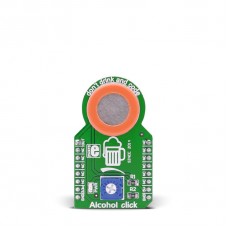Alcohol click
Alcohol click has a high sensitivity to alcohol and it can be used to detect alcohol in concentrations from 0.04 to 4mg/l.
Alcohol click carries an MQ-3 Semiconductor sensor for alcohol. The click is designed to run on a 5V power supply only. It communicates with the target microcontroller through the AN pin on the mikroBUS™ line.
MQ-3 sensor features
The gas sensing layer on the sensor unit is made of Tin dioxide (SnO2), an inorganic compound which has lower conductivity in clean air. The conductivity increases as the levels of alcohol gas rise.
Calibrating the sensor
To calibrate the sensor for the environment you’ll be using it in, Alcohol click has a small potentiometer that allows you to adjust the Load Resistance of the sensor circuit.
Key features
- MQ-3 sensor
- Concentration: 0.04-4mg/l alcohol
- Sensitivity: Rs(in air)/Rs(0.4mg/LAlcohol)≥5
- Interface: Analog
- 5V power supply
Specification
| Type | Gas |
| Applications | Portable alcohol detector, breathalyzer for estimating BAC (blood alcohol content) |
| On-board modules | MQ-3 Semiconductor sensor for alcohol |
| Key Features | Designed to use a 5V power supply |
| Key Benefits | Potentiometer for calibration |
| Interface | Analog |
| Input Voltage | 3.3V or 5V |
| Compatibility | mikroBUS |
| Click board size | M (42.9 x 25.4 mm) |
Pinout diagram
This table shows how the pinout on Alcohol click corresponds to the pinout on the mikroBUS™ socket (the latter shown in the two middle columns).
Programming
Code examples for Alcohol click, written for MikroElektronika hardware and compilers are available on Libstock.
Code snippet
The following code snippet shows how to initialize the click, and then read from it, showing the values on the display every 500 ms.
01 void main() {
02
03 LCD_Init(); // Initialize Lcd
04 Lcd_Cmd(_LCD_CLEAR); // Clear display
05 Lcd_Cmd(_LCD_CURSOR_OFF); // Cursor off
06 Lcd_Out(1,1,"Alcohol click"); // Write text in first row
07
08 ANSELA = 0x04; // Set ADC on RA2
09 TRISA = 0x04; // Set RA2 as input
10 LATA = 0; // Set PORTA as 0
11 ADC_Init(); // Initialize ADC
12 delay_ms(100); // Pause of 100ms for ADC module stabilization
13
14 //Initial read ADC and display PPM value on LCD
15 readSensor(); // Read sensor
16 calculatePPM(); // Calculating PPM value
17
18 FloatToStr(ppm,&txt); // Conversion float ppm to string txt
19 LCD_Out(2,14,"ppm"); // Print text on LCD
20 LCD_Out(2,1,txt); // Print txt value on LCD
21
22 while(1) {
23
24 delay_ms(500); // Pause 500ms
25 readSensor(); // Read sensor
26 calculatePPM(); // Calculating PPM value
27 FloatToStr(ppm,&txt); // Conversion float ppm to string txt
28 LCD_Out(2,1,txt); // Print txt value on LCD
29
30 }
31 }
Downloads
mikroBUS™ Standard specification
Enter the code in the box below:
















